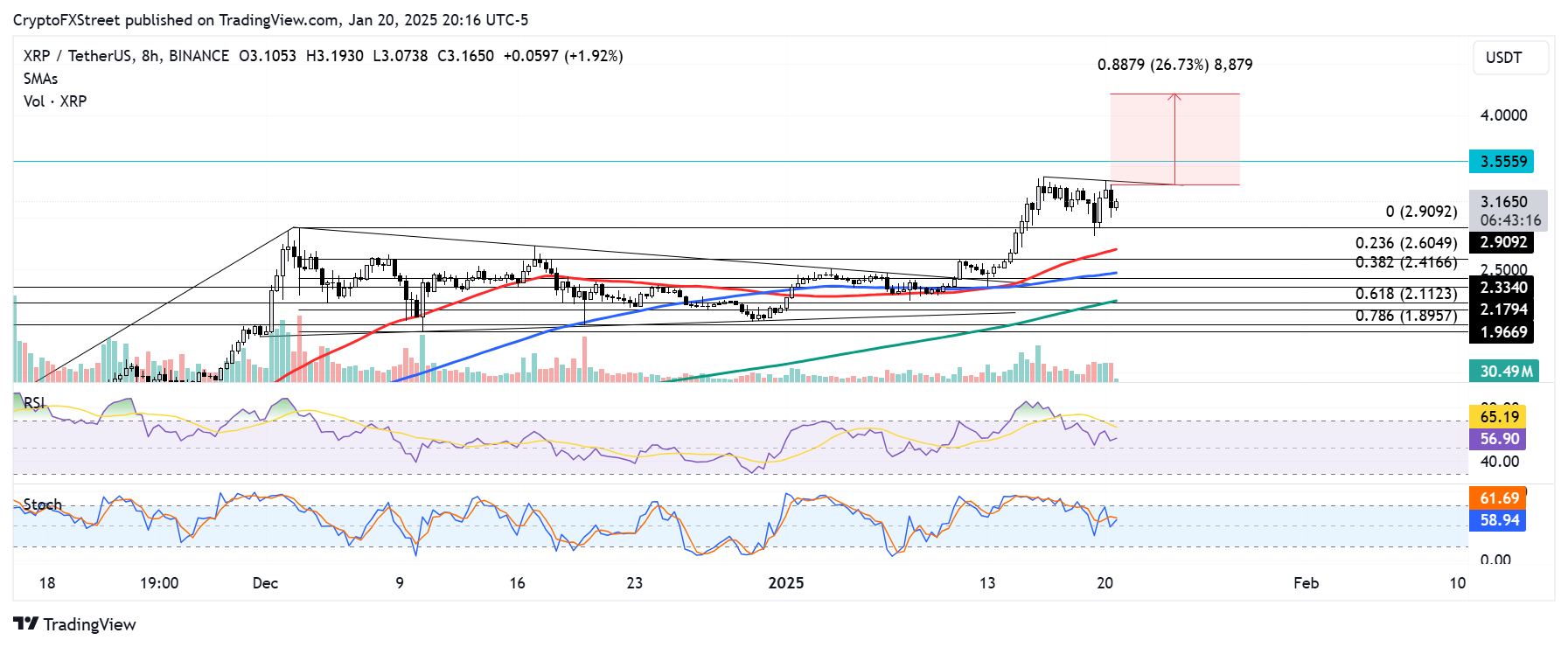Ripple's XRP set for new all-time high as President Trump announces pro-crypto Mark Uyeda as acting SEC Chair
- Ripple's case with SEC could be over with pro-crypto acting Chair Mark Uyeda now leading the agency.
- XRP on-chain activity reveals that whales have increased their buying pressure.
- XRP could rally to a new all-time high of $4.22 if it breaks above a bullish flag upper boundary.
Ripple (XRP) is up 5% on Monday after US President Donald Trump announced pro-crypto Mark Uyeda as the new acting Securities & Exchange Commission (SEC) Chair. The announcement follows increased buying activity across XRP spot market and investment products.
XRP sees rising bullish sentiment with new acting SEC Chair
Most crypto community members anticipate that the SEC may drop its appeal against Ripple after Gary Gensler resigned as SEC Chair on Monday.
Trump announced Commissioner Mark Uyeda as acting Chair on his first day in office. Uyeda has been highly critical of the agency's approach to the digital asset industry and is an advocate of clear crypto regulations.
XRP investment products recorded net inflows of $31 million, continuing its strong start to the year, per CoinShares data. The increased positive flows have sent its inflows since mid-November to $484 million without US investors' involvement.
The rising flows also indicate that spot XRP ETFs could be highly successful if approved by the SEC. According to Standard Chartered analysts, XRP ETFs could attract over $4.3 billion to $8.4 billion within the first six to twelve months of launch.
Meanwhile, XRP's whale transaction saw a spike in the past 24 hours, indicating increased activity from large holders.
 [02.17.52, 21 Jan, 2025]-638730195188191472.png)
XRP Whale Transactions. Source: Santiment
While many attributed the spike to selling activity after XRP briefly declined below $3.00, XRP exchange reserve declined and increased net outflows, suggesting that the whale transactions are tilted toward buying.

XRP Net Flows. Source: Coinglass
The brief decline potentially came from the derivatives market as XRP's open interest has declined from 2.34 billion XRP to 2.07 billion XRP in the past five days. However, XRP's funding rates have begun to improve, reaching a six-week high of 0.0143%. This indicates rising confidence toward the remittance-based token's long-term potential.
XRP could rally to a new all-time high at $4.22
XRP saw $25.67 million in futures liquidations in the past 24 hours, per Coinglass data. The total amount of liquidated long and short positions accounted for $15.86 million and $9.81 million, respectively.
On the 8-hour chart, XRP is forming a flag after rallying last week to break above a bullish pennant and its 2024 high of $2.90. If XRP holds $2.90 as a firm support, it could smash its all-time resistance of $3.55 and rally to $4.22. The level is obtained by measuring the height of the flag pole and projecting it upward from a potential breakout point.

XRP/USDT 8-hour chart
However, a breach of $2.90 could send XRP toward the $2.60 level, as evidenced by the 23.6% Fibonacci level, which is just below the 50-day Simple Moving Average (SMA).
Meanwhile, the Relative Strength Index (RSI) and Stochastic Oscillator (Stoch) momentum indicators are above their neutral levels, indicating dominant bullish pressure.
A daily candlestick close below $1.96 will invalidate the thesis.
Ripple FAQs
Ripple is a payments company that specializes in cross-border remittance. The company does this by leveraging blockchain technology. RippleNet is a network used for payments transfer created by Ripple Labs Inc. and is open to financial institutions worldwide. The company also leverages the XRP token.
XRP is the native token of the decentralized blockchain XRPLedger. The token is used by Ripple Labs to facilitate transactions on the XRPLedger, helping financial institutions transfer value in a borderless manner. XRP therefore facilitates trustless and instant payments on the XRPLedger chain, helping financial firms save on the cost of transacting worldwide.
XRPLedger is based on a distributed ledger technology and the blockchain using XRP to power transactions. The ledger is different from other blockchains as it has a built-in inflammatory protocol that helps fight spam and distributed denial-of-service (DDOS) attacks. The XRPL is maintained by a peer-to-peer network known as the global XRP Ledger community.
XRP uses the interledger standard. This is a blockchain protocol that aids payments across different networks. For instance, XRP’s blockchain can connect the ledgers of two or more banks. This effectively removes intermediaries and the need for centralization in the system. XRP acts as the native token of the XRPLedger blockchain engineered by Jed McCaleb, Arthur Britto and David Schwartz.

